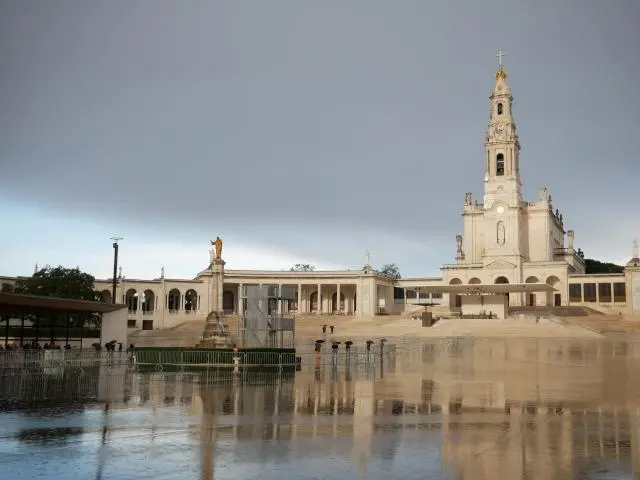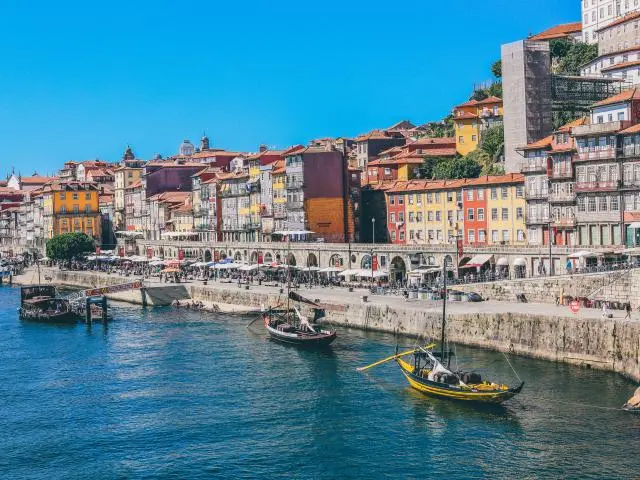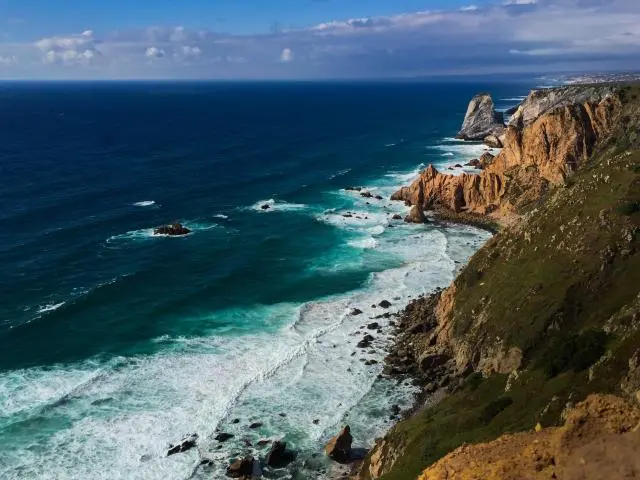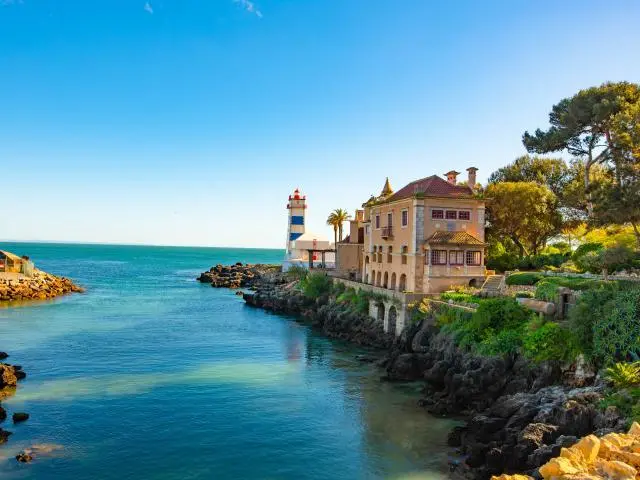Day 1 Lisboa - Tomar - Alcobaca - Batalha - Fatima (200 km)
Day 2 Fatima - Coimbra - Porto (129 km)
Day 3 Porto - Guimaraes - Braga - Porto (554 km)
Day 4 Porto - Viana do Castelo - Porto (319 km)
Day 5 Porto - Amarante - Vila Real - Douro Valley - Viseu (574 km)
Day 6 Viseu - Aveiro - Nazare - Obidos - Lisbon (228 km)
Day 7 Lisbon - Sintra - Cascais - Estoril - Lisbon (63 km)
Day 8 Lisboa - Evora (109 km)
Day 9 Evora - Beja - Silves - Lagos (225 km)
Day 10 Lagos - Ponta da Piedade - Sagres - Cabo de S. Vicente - Lagos (65 km)
Day 11 Lagos - Setubal - Serra da Arrabida - Lisbon (319 km)
Day 1:
Lisboa - Tomar - Alcobaca - Batalha - Fatima (200 km)
Travel through scenic landscapes dotted with windmills and orchards to Tomar, a city deeply connected to the Knights Templar. Visit the Convent of Christ, a UNESCO World Heritage site known for its rich history and architectural splendour. Continue to Alcobaca to admire its Gothic church and the romantic tombs of King Pedro and Ines de Castro. Then, head to Batalha to visit the Monastery of Santa Maria da Vitoria, a masterpiece of Gothic architecture and the resting place of Prince Henry the Navigator. Conclude the day in Fatima, home to the renowned Marian Shrine, with the possibility of attending the Candle Procession
-
Tomar, PORTUGAL
This small town in Portugal began within the walls of the Convento de Cristo, which was founded by the Knights Templar and remains one of the best places to visit in the entire country.
Convent of Christ
A former Roman Catholic convent in Tomar, Portugal. The convent and castle complex is a historic and cultural monument and was listed as a UNESCO World Heritage site in 1983.
-
Alcobaca, PORTUGAL
A city and a municipality in Oeste Subregion, region Centro in Portugal. The city became notable after the first king decided to build a church to commemorate the Conquest of Santarem from the Moors in 1147. The church later evolved into the Monastery of Alcobaca.
Alcobaca Monastery
This church and monastery were the first Gothic buildings in Portugal, founded in 1153. The main components of the complex are the royal tombs, the Chapel of St. Bernard, the royal Pantheon, the sacristy, and more.
-
Batalha, PORTUGAL
A town and a municipality in Portugal. The municipality population in 2011 was 15,805, in an area of 103.42 square kilometres. Here you can find the Batalha Monastery.
Batalha Monastery
Construction on this monastery began in 1386 and eventually wrapped up in 1517, spanning the reign of seven kings. It is a Dominican convent built in a Gothic style.
-
Fatima, PORTUGAL
Fatima is a civil parish in the municipality of Ourem, in the Portuguese Santarem District.
Sanctuary of Fatima
The Sanctuary of Fatima is a large, open public facility dedicated to the Virgin Mary. The site features many buildings, including a minor basilica and two small chapels.
Day 2:
Fatima - Coimbra - Porto (129 km)
Breakfast: Included|Lunch: Excluded|Dinner: Excluded
After breakfast, depart for Coimbra, a city steeped in
academic tradition. Visit its historic University, including
the breathtaking Joanina Library, a baroque
masterpiece, and learn about the traditions of its
students. Stop by the Church of Santa Clara, where
Queen Saint Isabel, known for the Miracle of the Roses, is
entombed. Continue to the vibrant city of Porto. Wander
its lively streets, admire the Ribeira district along the Douro
River, and immerse yourself in its rich heritage and famous
Port wine.
-
Coimbra, PORTUGAL
The third-largest city in Portugal, Coimbra was once the country's capital until roughly the end of the Middle Ages, and is filled with historical buildings and beautiful architecture.
Coimbra University
This university was established in 1290, making it one of the oldest continuously operated centers for higher education in the entire world. The beautiful campus is dotted with old, classical buildings.
Monastery of Santa Clara-a-Velha
The ruins of this medieval monastery in Coimbra sit on the banks of the Mondego River. After 12 years of restoration, the site reopened to the public.
Day 3:
Porto - Guimaraes - Braga - Porto (554 km)
Breakfast: Included|Lunch: Excluded|Dinner: Excluded
Explore Porto's treasures, from its riverside charm to its
impressive monuments, including the Stock Exchange
Palace and the Church of Sao Francisco. Head to
Guimaraes, the birthplace of Portugal, where the
medieval castle and the Palace of the Dukes of
Braganca take you back in time. In Braga, discover the
"Portuguese Rome," with its splendid cathedral and the
iconic Sanctuary of Bom Jesus do Monte, featuring its
baroque stairway and tranquil gardens.
-
Porto, PORTUGAL
Porto is the second-largest city in Portugal. This center of Portuguese urban life is more than one thousand years old and a registered UNESCO World Heritage Site. Porto also lends its name to port wine, which it first produced.
Church of Saint Francis
The most prominent Gothic monument in Porto, Portugal, being also noted for its outstanding Baroque inner decoration. It is located in the historic centre of the city, declared World Heritage Site by UNESCO.
-
Guimaraes, PORTUGAL
A city and municipality located in northern Portugal. Its historic town centre is listed as UNESCO World Heritage Site since 2001, in recognition for being an "exceptionally well-preserved and authentic example of the evolution of a medieval settlement into a modern town" in Europe.
Palace of the Dukes of Braganca
This medieval estate is the former residence of the first Dukes of Braganca. It fell into ruin and disrepair in the 16th century, but recent efforts have seen the complex restored to its original grandeur.
-
Braga, PORTUGAL
A city and a municipality in the northwestern Portuguese district of Braga, in the historical and cultural Minho Province.
Braga Cathedral
The Diocese of Braga has history dating back to he 3rd century. This cathedral was complete in the mid-13th century. The organ inside the church is renowned for its exquisite, intricate beauty.
Bom Jesus do Monte
This sanctuary, located just outside the city of Braga, is a notable pilgrimage site. The stairs leading up to the sanctuary itself are Baroque in style and climb 116 meters to the top.
Day 4:
Porto - Viana do Castelo - Porto (319 km)
Breakfast: Included|Lunch: Excluded|Dinner: Excluded
Depart for Viana do Castelo, a picturesque city where
history and scenic beauty merge. Visit the Basilica of
Santa Luzia, offering panoramic views over the city and
the Lima River. Stroll through the historic centre,
characterised by its cobblestone streets, traditional
buildings, and lively squares. Take time to explore the
shops showcasing local crafts, such as the famous filigree
jewellery, and enjoy the vibrant riverside promenade. The
charming ambiance of Viana invites you to immerse
yourself in its unique blend of maritime heritage and
cultural richness. Return to Porto for the evening.
-
Viana do Castelo, PORTUGAL
Viana do Castelo is a municipality in the Norte Region of Portugal. The population in 2011 was 88,725 in an area of 319.02 km2.
Basilica of Santa Luzia
Perched atop a hill, the Basilica of Santa Luzia is a iconic landmark of Viana do Castelo. This grandiose neo-Byzantine church offers breathtaking views of the Lima River and the Atlantic Ocean, attracting pilgrims and tourists alike.
Day 5:
Porto - Amarante - Vila Real - Douro Valley - Viseu (574 km)
Breakfast: Included|Lunch: Excluded|Dinner: Excluded
Begin the day in Amarante, known for its scenic beauty
and the legacy of Sao Goncalo. Visit Casa de Mateus in
Vila Real, an iconic manor house surrounded by exquisite
gardens. Travel through the breathtaking Douro Valley, a
UNESCO World Heritage site, stopping in Regua for a
delightful lunch. Continue to Pinhao, the heart of the Port
wine region, where the landscape of terraced vineyards
is unforgettable. End the day in Viseu, a historic city tied
to the legend of Viriato, the Lusitanian leader. Explore its
charming old town and vibrant commercial streets.
-
Amarante, PORTUGAL
A municipality and municipal seat in the northern Portuguese district of Porto, situated in the agricultural lands of the Minho region.
Sao Goncalo Monastery
Built in 1540, this baroque church and monastery in the beautiful Portuguese town of Amarante has some Italian Renaissance influenced features. On site are 4 statues of the kings who reigned during the church's construction.
-
Vila Real, PORTUGAL
Casa de Mateus
This magnificent Baroque manor in Vila Real was built in the first half of the 18th century to house the local nobility. As well as the grand interior, the gardens and grounds of the mansion are also impeccable.
-
Douro Valley, PORTUGAL
Douro Valley is a famed Portuguese wine region, renowned for its stunning terraced vineyards and the winding Douro River. As the homeland of Port wine, its landscape is a designated UNESCO World Heritage site.
-
Pinhao, PORTUGAL
Pinhao is a small town and there are grape vines everywhere. Due to the appropriate weather, this town produces many grapes used to make Port wines each year.
-
Viseu, PORTUGAL
A city and municipality in the Centro Region of Portugal, a regional economic hub with a strong wine industry and is the seat of international conglomerate Visabeira. The city is also a cultural center, home to the nationally acclaimed Grão Vasco Museum, seat of the Roman Catholic Diocese of Viseu.
Day 6:
Viseu - Aveiro - Nazare - Obidos - Lisbon (228 km)
Breakfast: Included|Lunch: Excluded|Dinner: Excluded
Travel to Aveiro, the "Venice of Portugal," with its
picturesque canals and colourful "moliceiro" boats.
Savour the city's traditional sweet, "ovos moles." Continue
to Nazare, a traditional fishing village renowned for its
giant waves, maritime charm, and vibrant atmosphere.
Take a stroll along its beachside promenade and admire
the colourful fishing boats. Finally, explore Obidos, a
stunning medieval town surrounded by well-preserved
walls, where you can wander its narrow cobblestone
streets lined with whitewashed houses adorned with
bougainvillaea. Don't forget to taste the famous cherry
liqueur, "ginjinha," served in a chocolate cup. Return to
Lisbon in the evening.
-
-
Nazare, PORTUGAL
It is one of the most popular seaside resorts in the Silver Coast/Costa de Prata, Portugal. It has long sandy beaches considered by some to be among the best beaches in Portugal.
-
Obidos, PORTUGAL
A town and a municipality in the Oeste Subregion in Portugal. Obidos remains a well-preserved example of medieval architecture; its streets, squares, walls and its castle are a popular tourist destination.
Day 7:
Lisbon - Sintra - Cascais - Estoril - Lisbon (63 km)
Breakfast: Included|Lunch: Excluded|Dinner: Excluded
Breakfast at the hotel. Departure towards to Sintra for a
luxury day. Visit the palace of Sintra and walk through this
charming village. Enjoy an amazing view from the
westernmost point of Europe (Cabo da Roca). Along the
cost we pass by one of the most famous surfing beaches,
the incredible Boca do Inferno, the cosmopolitan Cascais and the gardens of Estoril Casino. Return to Lisbon.
-
Sintra, PORTUGAL
Sintra has the most historic buildings and equipped with the natural scenery that signifies the beauty of Portugal. It is approximately 18 miles from Lisbon to Sintra where is also known as the most enchanting city.
Cabo da Roca
Cabo da Roca is the westernmost point in all off Portugal, located in Sintra, one of the suburbs of Lisbon. Just offshore, one can see beautiful granite boulders that rise from the sea.
-
Cascais, PORTUGAL
Cascais is a wealthy, coastal suburb of the city of Lisbon. There are many activities to do in the area, from beach sports like surfing and sailing to gold and tennis.
Boca do Inferno
The name of this seaside chasm off the coast of Cascais in English means "Hell's Mouth." It became a popular tourist attraction because of the way seawater gets sucked into the chasm and splashed against the rock walls.
-
Costa de Estoril, PORTUGAL
Estoril is a town in the Municipality of Cascais, Portugal, on the Portuguese Riviera.It is famed as a luxury entertainment destination on the Portuguese Riviera, as home of the Casino Estoril.
Casino Estoril
The casino in Estoril, a suburb of Lisbon, is the largest in Europe. In World War II, it was a rumored meeting spot of spies, adventurers, and dispossessed royals, making it the inspiration for Ian Fleming's Casino Royale.
Day 8:
Lisboa - Evora (109 km)
Breakfast: Included|Lunch: Excluded|Dinner: Excluded
Today we will have one day time discovering the town of Evora. We will cross the bridge over the river Tejo till we arrive at Evora. In the narrow streets of the whitewashed town, we will walk along the time visiting some of the most important monuments: the Roman Temple, the Romanesque-gothic Cathedral, Saint Francis Church with the "Bones Chapel" and the University. At the market we will see and feel the richness of product used to prepare one of the most elaborated and appreciated gastronomies of Portugal. Along the visit we will also admire the diversity and authenticity of local handicraft with cork, ceramic and copper objects. Then we will have a lunch. In the afternoon, we will have free time for a better discover of the city. Overnight in Evora.
-
Evora, PORTUGAL
Evora is a city and a municipality in Portugal. Due to its well-preserved old town centre, still partially enclosed by medieval walls, and a large number of monuments dating from various historical periods, including a Roman Temple, Evora is a UNESCO World Heritage site.
Roman Temple
This temple to the ancient Roman goddess Diana was built in the first century C.E. in homage to the emperor Augustus. It is located in the town's central square.
Cathedral of Evora
One of the oldest monuments in the Portuguese city of Evora, the local cathedral was first built between 1184 and 1204, right after the city was recaptured from Arab rule. Over the years, many additions were made.
University of Evora
The second oldest college in Portugal, Evora's university was established in 1559 and serves a student body of about 10,000. In 1973, it became a state-run public school, dropping its prior religious affiliation.
Igreja de Sao Francisco
This Gothic church was built in the early 16th century. It is most famous for its Chapel of Bones, which is filled with the bones of Franciscan monks, one of the city's most famous monuments.
Day 9:
Evora - Beja - Silves - Lagos (225 km)
Breakfast: Included|Lunch: Excluded|Dinner: Excluded
After breakfast in the morning, we will spend a little bit of leisure time in Evora before driving south to Beja, where a medieval castle and tower dominate the region. Then we will cross the mountains into the Algarve region, eventually coming to Silves, after which we will head to Lagos for the evening.
-
Beja, PORTUGAL
A city and a municipality in the Alentejo region, Portugal.The Portuguese Air Force has an airbase in the area – the Air Base No. 11.
-
Day 10:
Lagos - Ponta da Piedade - Sagres - Cabo de S. Vicente - Lagos (65 km)
Breakfast: Included|Lunch: Excluded|Dinner: Excluded
After breakfast, we will make our way to Ponta de Piedade to admire the magnificent view of the Atlantic Ocean. Then, we will continue to Sagres, a fishing port, where we will visit the Fortress on Sagres Point. As we continue along the coastline, we will reach Cabo Sao Vincente and the city of Lagos, where we will get to sample delicious seafood. Afterwards, we will return to the hotel in the afternoon before getting a chance to go swimming.
-
Sagres, PORTUGAL
Sagres Point
This promontory in southern Portugal is home to a fortress. The area was very important during the Portuguese Age of Discoveries. There was once a school of navigation located on the peninsula.
Day 11:
Lagos - Setubal - Serra da Arrabida - Lisbon (319 km)
Breakfast: Included|Lunch: Excluded|Dinner: Excluded
In the morning, we will take a last look at the water while we travel along the coast on our way back to Lisbon. During the journey, we will stop in Setubal, a major port and industrial center. Then we will take the scenic route over the Arrabida Mountain Range, which will provide us with amazing views of Lisbon as we approach the city from high above. When we eventually arrive, the tour will come to an end. Please see "Departure and Return" for more detailed information regarding pickup and drop-off times and locations.









 1-Day Fatima, Obidos, Batalha and Nazare Tour from Lisbon...
1-Day Fatima, Obidos, Batalha and Nazare Tour from Lisbon...
 11-Day The Best of Portugal Tour
11-Day The Best of Portugal Tour
 3-Day Wonders of Portugal Tour
3-Day Wonders of Portugal Tour
 6-Day North of Portugal Tour
6-Day North of Portugal Tour
 4-Day South of Portugal Tour
4-Day South of Portugal Tour